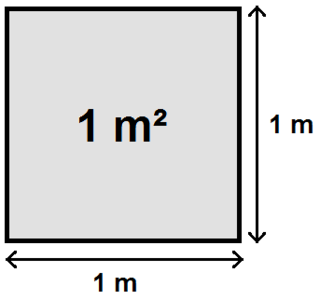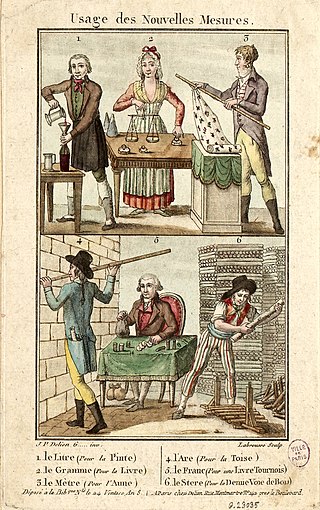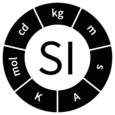
A centimetre or centimeter, with SI symbol cm, is a unit of length in the International System of Units (SI) equal to one hundredth of a metre, centi being the SI prefix for a factor of 1/100. Equivalently, there are 100 centimetres in 1 metre. The centimetre was the base unit of length in the now deprecated centimetre–gram–second (CGS) system of units.

The kilogram is the base unit of mass in the International System of Units (SI), having the unit symbol kg. It is a widely used measure in science, engineering and commerce worldwide, and is often simply called a kilo colloquially. It means 'one thousand grams'.
Kilo is a decimal unit prefix in the metric system denoting multiplication by one thousand (103). It is used in the International System of Units, where it has the symbol k, in lowercase.

The litre or liter is a metric unit of volume. It is equal to 1 cubic decimetre (dm3), 1000 cubic centimetres (cm3) or 0.001 cubic metres (m3). A cubic decimetre occupies a volume of 10 cm × 10 cm × 10 cm and is thus equal to one-thousandth of a cubic metre.
Mega is a unit prefix in metric systems of units denoting a factor of one million (106 or 1000000). It has the unit symbol M. It was confirmed for use in the International System of Units (SI) in 1960. Mega comes from Ancient Greek: μέγας, romanized: mégas, lit. 'great'.

The micrometre as used by the International Bureau of Weights and Measures; SI symbol: μm) or micrometer, also commonly known by the non-SI term micron, is a unit of length in the International System of Units (SI) equalling 1×10−6 metre ; that is, one millionth of a metre.

The International System of Units, internationally known by the abbreviation SI, is the modern form of the metric system and the world's most widely used system of measurement. Coordinated by the International Bureau of Weights and Measures it is the only system of measurement with an official status in nearly every country in the world, employed in science, technology, industry, and everyday commerce.

The tonne is a unit of mass equal to 1,000 kilograms. It is a non-SI unit accepted for use with SI. It is also referred to as a metric ton in the United States to distinguish it from the non-metric units of the short ton and the long ton. It is equivalent to approximately 2,204.6 pounds, 1.102 short tons, and 0.984 long tons. The official SI unit is the megagram (Mg), a less common way to express the same amount.

The metric system is a decimal-based system of measurement. The current international standard for the metric system is the International System of Units, in which all units can be expressed in terms of seven base units: the metre, kilogram, second, ampere, kelvin, mole, and candela.

The pascal is the unit of pressure in the International System of Units (SI). It is also used to quantify internal pressure, stress, Young's modulus, and ultimate tensile strength. The unit, named after Blaise Pascal, is an SI coherent derived unit defined as one newton per square metre (N/m2). It is also equivalent to 10 barye in the CGS system. Common multiple units of the pascal are the hectopascal, which is equal to one millibar, and the kilopascal, which is equal to one centibar.

The square metre or square meter is the unit of area in the International System of Units (SI) with symbol m2. It is the area of a square with sides one metre in length.
Deca-, sometimes deka-, is a common English-language numeral prefix derived from the Late Latin decas, from Ancient Greek δέκας (dékas), from δέκα. It is used in many words.

Deci- is a decimal unit prefix in the metric system denoting a factor of one tenth. Proposed in 1793, and adopted in 1795, the prefix comes from the Latin decimus, meaning "tenth". Since 1960, the prefix is part of the International System of Units (SI).
A unit prefix is a specifier or mnemonic that is prepended to units of measurement to indicate multiples or fractions of the units. Units of various sizes are commonly formed by the use of such prefixes. The prefixes of the metric system, such as kilo and milli, represent multiplication by positive or negative powers of ten. In information technology it is common to use binary prefixes, which are based on powers of two. Historically, many prefixes have been used or proposed by various sources, but only a narrow set has been recognised by standards organisations.

France has a unique history of units of measurement due to its radical decision to invent and adopt the metric system after the French Revolution.

The kelvin, symbol K, is the base unit of measurement for temperature in the International System of Units (SI). The Kelvin scale is an absolute temperature scale that starts from 0 K, the coldest possible temperature, then rises by exactly 1 K for each 1 °C. The Kelvin scale was designed to be easily converted from the Celsius scale. Any temperature in degrees Celsius can be converted to kelvin by adding 273.15.

The cubic metre or cubic meter is the unit of volume in the International System of Units (SI). Its symbol is m3. It is the volume of a cube with edges one metre in length. An alternative name, which allowed a different usage with metric prefixes, was the stère, still sometimes used for dry measure. Another alternative name, no longer widely used, was the kilolitre.

The history of the metric system began during the Age of Enlightenment with measures of length and weight derived from nature, along with their decimal multiples and fractions. The system became the standard of France and Europe within half a century. Other measures with unity ratios were added, and the system went on to be adopted across the world.

The following outline is provided as an overview of and topical guide to the metric system:















